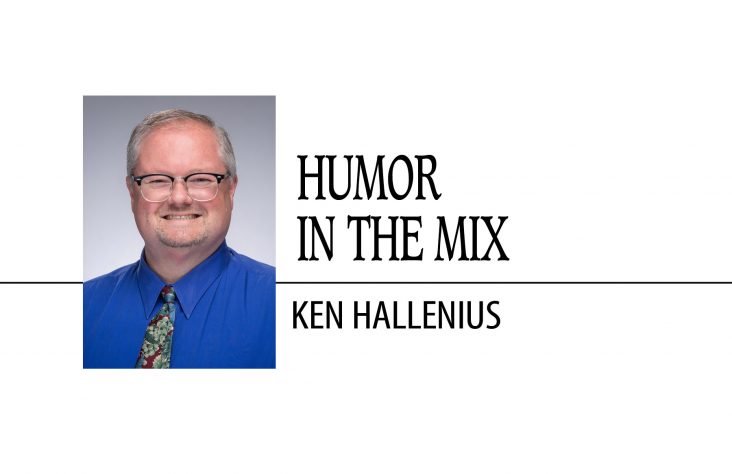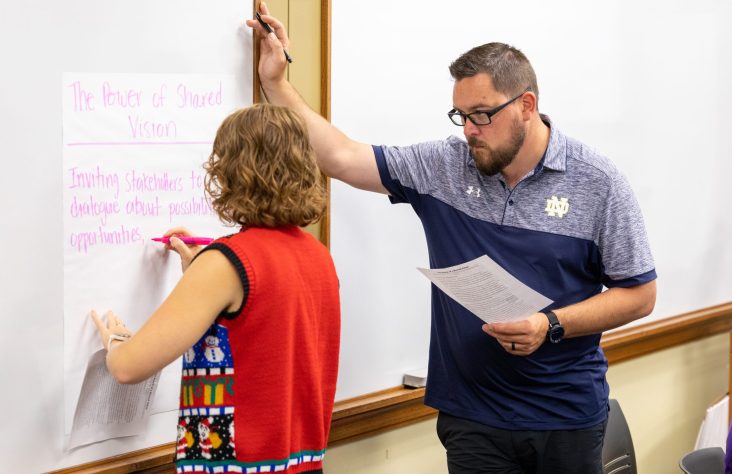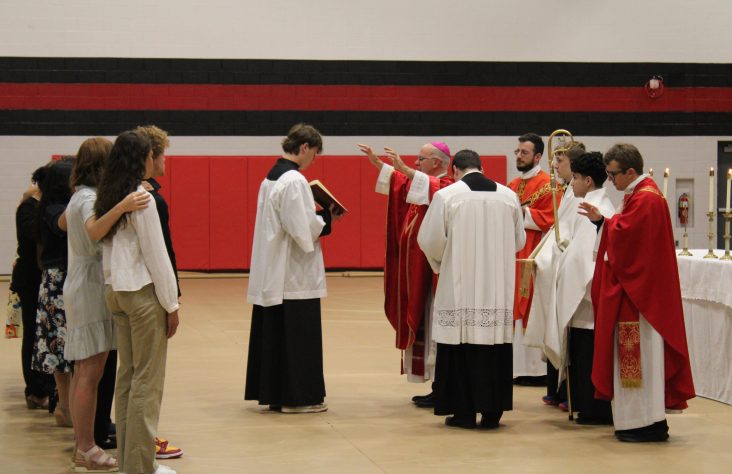March 28, 2017 // Parish
St. Pius X Church dedicated: ‘A place whose beauty gives honor and glory to God’
Granger parish celebrates new worship space
Click here for more photos from the event
Click here for the 8-page pullout section from the dedication
On Saturday, March 25, the gloom of a morning rain contrasted the energy and excitement of Granger’s St. Pius X parish community as members gathered to celebrate the long-awaited dedication of their new church. This two-year construction project culminated with a Mass celebrated by Bishop Kevin C. Rhoades.
“This new church will edify the parishioners and, even more, will be a place whose beauty gives honor and glory to God,” the bishop wrote in a letter to the community.
He went on to write that the church will also “help the parish continue its great mission.”
Parish pastor Msgr. William (Bill) Schooler, who came to St. Pius in 2001 and has overseen much of the church construction project, was visibly elated as he concelebrated alongside Bishop Rhoades, Bishop R. Daniel Conlon of the Diocese of Joliet, fellow parish priest Father Bill Meininger and approximately 50 diocesan, visiting and Holy Cross priests whose presence underscored the parish’s Holy Cross roots.
The celebration began with the Angelus at noon. From the outdoor courtyard of the church, via projection screen, Bishop Rhoades led the congregation gathered inside the church in prayer. At the conclusion of the Angelus, Bishop Rhoades, alongside his fellow celebrants, proceeded into the church. As the celebrants entered, the congregation rose to sing “Let Us Go Rejoicing,” a hymn whose verse, “Let us go rejoicing to the house of the Lord,” accurately described the moment.
During the Blessing and Sprinkling Rite that followed the procession, Bishop Rhoades prayed: “Brothers and sisters in Christ, in this solemn rite of dedication, let us ask the Lord our God to bless this water created by his hand. It is a sign of our repentance, a reminder of our baptism and a symbol of the cleansing of these walls and this altar.”
During his homily Bishop Rhoades drew connections between the new church building becoming a true place of worship — a dwelling place of the Lord — as it goes forward from the dedication Mass, and the transformation that catechumens undergo as they prepare to eventually become dwelling places for the Lord as members of the Catholic Church. He also highlighted the similarity of the joy brought by the dedication day celebration to the joy of Easter.
“This building is like our catechumens and today is like the Easter Vigil for this beautiful building made of stone, wood, steel and tile,” he said. “Already, the walls and the altar have been sprinkled with the holy water that is used in baptism. Soon, the walls and the altar will be anointed with the same holy chrism that is used at baptisms, confirmations and priestly ordinations. This building will thus become a church, a house of God.
“At this Mass, this church is being dedicated and consecrated to the Lord,” he went on to say. “It will become a sacred building and reserved for sacred worship. And this block of stone will become an altar, which henceforth will only be able to be used for the eucharistic sacrifice, the banquet of the Lord. “
The bishop later recognized the hard work of Msgr. Schooler in making the construction of the church possible, by drawing a parallel between his leadership and that of great biblical leaders.
“I am very grateful to Msgr. Schooler, who has been both your King David and King Solomon in this wonderful project.” His words were followed by long applause and visible appreciation on the part of Msgr. Schooler. In his closing remarks at the end of Mass, Msgr. Schooler referred to his staff as “amazing.” He also recognized the “sacrifices of the parish” to see the project through to completion.
The Mass included the Litany of the Saints, led by the choir and instrumental ensemble and the placement of a relic of St. Pius X into the altar. The bishop anointed the altar and 12 places within the church, signifying that the altar and walls “are given over entirely and perpetually to Christian worship.”
Instrumentalist Mary Barnard, who was a member of the parish’s music ministry for many years and recently moved to Florida, came back to Granger for the dedication Mass.
“I wanted to come back to be a part of this, because I’ve been a part of this community for like 20 years. It was so it was important for me to be here to see the culmination of all of our work,” she said. “I miss this very much.”
Like Barnard, fellow instrumentalist Karen Stonehill also cherishes the St. Pius Parish community.
“You see Father Bill, Jeremy (liturgy and music director) and our principal — you see their faith and everything come alive in their actions,” Stonehill said. “It’s just kind of a reflection of who we are as a church… a celebration of our faith as a family.”
The growth of the parish, indicative of the growth of the Granger area, is certainly evident and parallels the need to implement this project years ago.
“When I was first ordained and serving as the associate pastor of St. Matthew Cathedral and chaplain at Marian High School, traveling to St. Pius X in Granger to help with a penance service was a trip to a small parish in the middle of the countryside,” Msgr. Schooler said. “Returning as pastor in 2001, I encountered a very different reality. We have been working on adjusting to the new reality of 3,200 families by dedicating a new Parish Education Center in 2008 and dedicating a new church on March 25th of this year.”
Eighteen-year parish member Mike Stesiak described the dedication as “beginning a new series or a new chapter of the church.” His brother, Jeff Stesiak, said one of his favorite aspects of the new church was the altar. He also applauded Msgr. Schooler for his leadership.
“He is such a dynamic leader of this parish. He’s brought everyone together and I don’t know that it could have been done without him, to be honest with you,” Stesiak explained.
Building toward
dedication day
In anticipation of the dedication, the parish sought active member engagement through a construction guessing game and a parish-wide vote to name two of the four new church bells. Additionally, parishioners could participate in Name That Mass Tune, a game rolled out on social media that involved guessing various church hymns — some of which were incorporated into the dedication Mass.
Union Iron Workers celebrated no injuries or lost time while constructing the church, and, following its tradition, placed a Christmas tree and American flag on the last steel beam secured into the church’s structure last year — an occasion watched by the school community.
Paul Johns has been a sacristan for a few years at St. Pius and serves as a member of parish council. He has witnessed the construction of the new church firsthand.
“I’ve been able to come in at various stages throughout the development of the building process… from when they were pouring floors to where it is now. It’s really been a great process, to see everything come together and how beautiful the end result has been.”
Ellen Bruneel, who also serves as a sacristan, was similarly enthusiastic.
“Really, every little detail has so much meaning. Any one piece of it doesn’t represent the whole, just like the community of the church,” she said. “Every different piece of the architecture was so well thought of. Every component of is individually beautiful and comes together to create something even greater, just like the body of the church and its members.”
Architectural
elements
With a prominent brick façade and magnificent bell tower complete with cast iron bells, the new church can hold 1,320 worshipers among its 112 pews and 104 seats. With a parish that has more than doubled over the past 10 years to approximately 10,000 individual parishioners, the construction was a necessary next step in continuing to build community at the parish and accommodate its growth.
Modeled in the Romanesque style, the church incorporates its long-time relationship and history with the University of Notre Dame. Above the altar, in one of the murals depicting several saints, is Blessed Basil Moreau, the priest who started the Holy Cross Order of which the University of Notre Dame’s founder, Father Edward Sorin, was a member. There is also a small prayer space with a statue of St. André Bessette, a Holy Cross brother and the first Holy Cross saint. Additionally, the base of the crucifix above the altar is modeled after the Holy Cross coat of arms.
Also relevant to St. Pius’ connection to Notre Dame are the set of organ pipes gifted to the parish from the university. St. Pius worked with an Illinois-based supplier to have the previously used pipes combined with refurbished pipes from the parish’s old organ. The base of the organ is new.
The parish engaged several local entities to assist with the edifice’s creation, including Alliance Architects to design the church and a local woodworker to craft the crucifix suspended over the altar and the bases for the Stations of the Cross.
Along the main aisle of the church are murals of the 12 Apostles, with the Gospel writers located closest to the altar. Mosaics of the covenants, including that of Adam and Eve, Noah, Abraham, Moses, David and Jeremiah, line the floor leading to the altar. Decorative mosaic vines line the inside walls of the building. In the entryway of the courtyard connecting the new church to the old church — which will soon be completely transformed into the parish gathering area — there is a mosaic depicting the devil as a snake. The mosaic says, in Latin, “step on his head.”
The altar from the old church will be reused in the Blessed Sacrament Chapel of the new church, located in the apse of the sanctuary. In his words to the congregation, the bishop applauded the parish for giving the faithful 24-hour access to this new chapel.
Father Daniel Scheidt, former associate pastor of the parish, served as liturgical designer for the new St. Pius X, and as such was very influential regarding the artwork incorporated throughout the church. “He came up with a lot of these ideas,” Msgr. Schooler said.
“Father Dan Scheidt had a lot to do with the planning of the art, choice of saints and the overall schema for all the artwork,” Father Meininger added. He emphasized how the artwork brings elements of beauty and education to the church space.
“I am so thrilled that we were able to work into our budget to have so much decoration, so much artwork. Not just for the mere fact that it’s beautiful; but it teaches.
“The saints that we chose and the different things that we have, such as the fir, elm, apple and birch (trees) at the crossing at the front of the church, represent street names of roads around the area,” he went on to say, “Not only does the artwork teach us about our faith, but it sort of tells the story of this community… it very much cements us in history.”
Historical overview of the parish
Formally established in 1956, and much like the University of Notre Dame, the parish is rooted in the vision of Father Edward Sorin. St. Joseph’s Farm in Granger, which Father Sorin shared with his Holy Cross brothers, sisters and fellow priests starting in 1870, allowed the Holy Cross Order to serve the surrounding rural community. It was not until 1936 that the farm started to be referred to as a parish community, and 20 years passed before it officially became known as a parish.
Over time, the small chapel at the farm became too small for the growing faith community. A plot of land off Fir Road was gifted to the parish in the early 1950s; the same plot of land on which the church sits today.
The growth of the parish paralleled the growth of the area, and a new rectory was completed in 1970 to accommodate it. This was followed by the construction of a parish center and gym in 1986, and a new church and adjoining offices between 1989 and 1991.
Msgr. Schooler was the first diocesan priest assigned to the parish. Before he came, all parish priests were of the Congregation of the Holy Cross. The fact that the parish has, as he mentioned in his final comments during Mass, “not forgotten our Holy Cross roots” by incorporating facets of the Holy Cross influence into the new church, is symbolic of the current community’s appreciation of that Holy Cross connection.
Father Peter Jarrett, who served at St. Pius from 1995-2001, was the parish’s last Holy Cross pastor. A concelebrant of the dedication Mass, Father Jarrett described the new church as a “tribute to the parish community’s dedication in faith, to Msgr. Schooler, and to Holy Cross.”
Planning and funding
Starting approximately five years ago, several committees were formed to plan for the parish facilities expansion and to oversee funding and the construction of the project. The project began following a parish strategic planning process in 2011. The formation of a Facilities Committee followed in 2012, which involved a thorough investigation of existing space needs within the parish. The Campaign Leadership Team led a parish capital campaign beginning in 2013. The Building Committee met to advise Msgr. Schooler and the architects on specifics of the building plans. In addition to the architects and many members of the parish staff, several parish members served on these committees. Kim Mauch, St. Pius director of communications and marketing, explained that parish members were engaged as “part of the stewardship philosophy at St. Pius.”
The campaign launched in July 2013 after receiving approval from the diocese. The project was based on dual financing, with funding stemming from pledges and parish savings.
The cost of the three-part project totaled $19 million, including construction of a new rectory, new church, renovation of the existing church and offices and a two-story addition to the Parish Education Center. Over 1,600 parish families and members of the community have participated in the capital campaign, pledging over $14 million so far.
Embracing stewardship as a way of life, but recognizing that each individual parish member or family could contribute a different amount, the parish did not incorporate naming opportunities for large gifts.
“Of course we could not have built this church without large gifts, for which we are extremely grateful. Yet, when we invited our parish community to participate in the campaign, we did not ask for equal gifts, but for equal sacrifice,” Betsy Quinn, director of stewardship and evangelization, said.
Construction schedules ran on time, for the most part, and the parish expects the same for the remainder of the project. The renovation of the old church into a gathering space, a baptistery, a parish library and meeting rooms is underway and on target to be completed later this summer.
Renovation has also begun on the parish offices. Their redesign will include a reception area, central working area with designated offices, a workroom, two conference rooms and additional storage space.
Before the capital campaign launched, parish staff had to complete work with consultants and assess needs. “Once a month, we would tour the facility at 6:30 a.m. in the morning and decide what exactly do we need, where do we need more space, how can we prioritize these things,” Father Meininger said. As they reviewed those needs, the parish continued to grow and decisions had to be made with little knowledge of the growth trajectory. Estimating the number of seats that would be needed in the church years after the capital campaign launched was a challenge.
“That was one of our huge decisions that we had to make,” Msgr. Schooler said. “Cost was a major factor…. when I came in 2001, we knew even at that time that the facilities were not adequate for the size. When they (first) built St. Pius they had thought that they were going to build another parish in Granger.”
The future — an opportunity to use resources for good
The bishop noted the progression of the parish’s development in his letter to the St. Pius community.
“When we think back to the first parishioners and your ancestors in faith at St. Pius, we see that they were not only thinking about themselves. They were thinking about their children, grandchildren and future generations. They made incredible sacrifices and every generation is called to do the same, making the new church a gift to future generations,” he said.
E-Book PDF: Open in New Window | Download
The best news. Delivered to your inbox.
Subscribe to our mailing list today.






